Movie Review
 |
 |
 |
 |
 |
 |
 |
A Flawed & Mundane Mary of Nazareth
(2022 television movie directed by Giacomo Campiotto)
Christina Herath
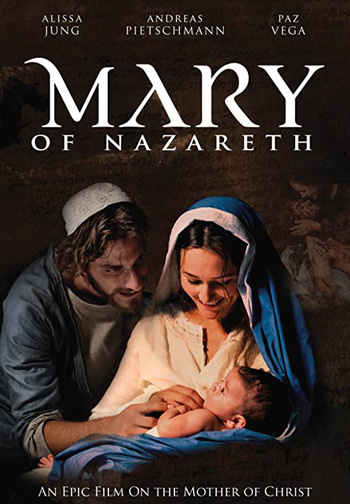
A naturalist portrayal of Mary with many errors & blasphemies; below, the 3 feminist characters: Mary, Magdalene & Herodias
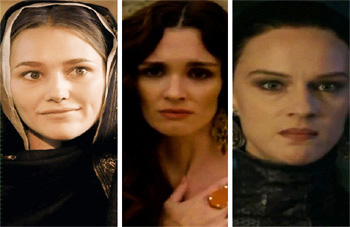
The writers of Mary of Nazareth took the freedom to create their own history for almost the entire movie. Many times and in significant ways, they have added their own vulgar, egalitarian and feminist ideas to Our Lady’s Sacred History.
I take the liberty to liken this movie to a fan fiction, where amateurs make up their own stories about real persons. This will not be difficult to see as we look through the film.
Making Our Lady’s extraordinary life ‘normal’
In this life rendition, the Blessed Mother shares the stage with two other characters, Mary Magdalene and Herodias, the wicked woman who conspired to behead St. John the Baptist.
Our Lady is portrayed as an ordinary young girl, dreamy, exuberant, a “best friend” of Mary Magdalene, who is timid and shy. Our Lady accepts Mary Magdalene as a bad childhood companion and even visits her in Herod’s palace where Magdalene assumes the life of a prostitute. An invented story, not history. Sacred History teaches us that Our Lady entered the Temple at age three and grew up there; she was not a childhood friend of Magdalene, nor would she condone such bad behavior.
Then there is the new feminist Herodias, who in historical records never appears with Mary Magdalene or Our Lady. But here, she is portrayed as even more active in trying to find and kill the Messiah than is Herod himself.
Another outrageous falsity: We see Magdalene as instrumental in the killing of John the Baptist. This is a vicious and feminist remaking of History, not the Gospel of Jesus Christ.
A flawed order of events
In the real life of Our Lady, her wedding to St. Joseph took place before the Incarnation of God the Son, of course. Anne Catherine Emmerich narrates their “marriage feast” as taking place before the Annunciation and after her espousal to St. Joseph in the Temple.
In this film, however, the wedding of Mary takes place way after the Annunciation and Visitation.
Those who wrote the movie's script ignore one of the most important reasons for the Blessed Virgin’s and St. Joseph’s marriage: to conceal the pregnancy that will save us. This confusing and untrue order of events leads to a lot of embarrassment for their Mary as everyone looks upon her with suspicion and disdain.
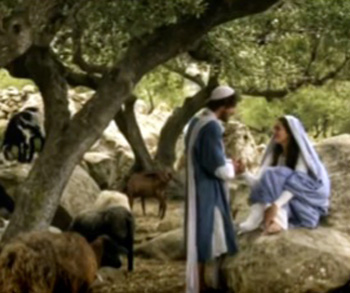
St. Joseph wooing Mary, an ordinary modern romance
Everything was holy, noble and miraculous, with the staff of St. Joseph blossoming with a lily to signify his worthiness to be the spouse of the Virgin and Foster Father of Our Lord Jesus Christ.That is the true history.
But, there was no blossoming staff or solemn Temple gathering in this movie.
We are shown Joseph making his way to the house of Joachim and Anne to woo their daughter. Joachim is unimpressed, but Anne gives her permission, another cinema concession to feminism. On his way, he meets Magdalene, who, as a "best friend" of Mary, gives him some advice on how to succeed in his suit. What a modern, every day event! Nothing special.
A little later Joseph asks Joachim for his daughter’s hand while Mary and Magdalene sit nearby. Mary whispers to Magdalene something along the lines of “it’s good that someone can stand up to my father,” a very feminist line that would never come from the lips of the Virgin, even if the scene were historically accurate – which it is not.
Fast forward and we witness another fictional scene: Magdalene’s mother is being stoned for committing adultery, which spurs Magdalene to leave her father’s house and join Herodias at her place to engage in a life of sin. All of this comes from the minds of malicious writers, not Scriptures or Tradition.
Mary accompanies "her friend," doing little to dissuade her from this bad course. This sends the message to youth that Our Lady will not stop you from sinning or chastise you; she remains your "friend" and accepts you as you are – a tremendous lie. This fictional Mary also does nothing when Herodias questions God ‘s existence. Which tells viewers that they should also remain quiet and show toleration when the wicked, blasphemers and heretics insult and question our God, His Church and the Catholic Faith He has given us.
The Annunciation
Even before the Archangel Gabriel arrives, we have a blasphemous scene of Mary – who Scriptures teaches us is without original sin – being tempted by unchaste thoughts that rise from what she has heard from Herodias and Magdalene in the past.
The Archangel Gabriel appears and walks about strangely, without even kneeling reverently to greet his Queen. When Mary asks the Angel how she can conceive, the Angel simply points out that her cousin Elizabeth has conceived in her old age. Nothing miraculous, nothing supernatural in the Angel’s words. It is an insult to the perpetual virginity of Our Lady.
After the Angel leaves, she strolls off dreamy eyes, smiling and triumphant into town, a typical modern teen.
The Visitation
Sacred Tradition tells us that St. Joseph accompanied Our Lady on Her visit to St. Elizabeth’s house.
However, the film’s feminist Mary must convince Joseph to let her make the journey alone. The worldly embrace at their parting is not holy and contradicts Ven. Mary of Agreda, who tells us that Our Lady was accustomed to beseech St. Joseph’s blessings on bended knees before betaking a journey.
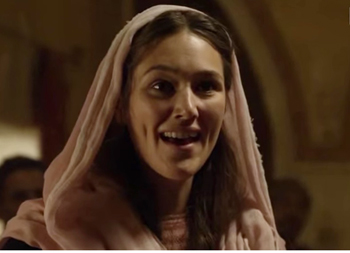
Mary wanders around the room reciting the Magnificat; later she stops to visit Magdalene at Herodias' palace
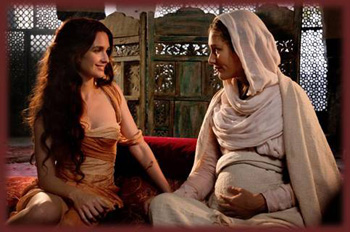
Meanwhile, in Herod’s sinful palace, we see Magdalene dancing immodestly before the prince Antipater and her private encounter with him. This is very lustful and should not be viewed by any Catholic, young or old.
Notwithstanding, the visibly pregnant Mary visits Magdalene again on her way back to Nazareth and sits to talk with her immodestly dressed friend. Again and again, viewers receive the message: As Our Lady’s friend, you do not have to worry about living a sinful life, wearing immodest clothes and wallowing in lust, for she will still love you and be tolerant with your immoral life.
A shamed Mary & uncontrolled Joseph
As Mary returns home, the villagers note her pregnancy and disapprovingly point at her. Then, when Joseph finds out, he throws such a tantrum that he lays a violent hand on Mary’s face. Later we see Mary facing the anger of her father and mother and Joseph chasing away all the workers who were building their future home.

A temperamental St. Joseph strikes Our Lady & tears down the house in anger
It is a daft insult to even imagine that St. Joseph could act in this way.
Finally, we must watch a wedding ceremony attended by disapproving persons, all looking disrespectfully at the pregnant bride. It is all heretical and blasphemous.

Disapproving looks & scorn for a visibly pregnant Mary at her ‘wedding party’
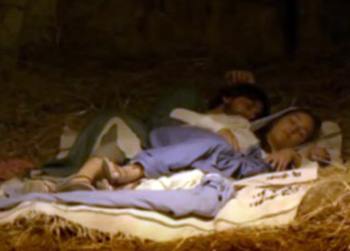
The Holy Couple in a familiar casual embrace
- There is no Glorious Birth. Mary sits in a cave in Bethlehem, visibly agitated and gasping as the birth of her Son nears. The creators of this film certainly imply a painful birth, making them guilty of blasphemy.
- The Angels visiting the shepherds with tidings of joy have been omitted. The shepherds come to meet the Holy Family and it was very uncomfortable to see Joseph sleeping so close to Mary in a vulgar position.
- In the Temple at the Presentation, Mary does not understand Simeon’s prophecy about the suffering her Son will undergo. This is ridiculous. Our Lady knew the prophecies of the Old Testament perfectly. She also had infused knowledge and was aware that her Son would be the Man of Sorrows, as the Prophet Isaiah had called Him.
- Much later Our Lord is in a synagogue and the offended Jews call him the “son of a carpenter.” A woman in the crowd retorts, “No worse, who knows whose child he is?” The real Mary was never a cause of scandal but was highly respected by all, her very presence demanded reverence.
- According to Sacred Tradition, St. Joseph died in the arms of Jesus and Mary and the cause of his death was love. The Angels surrounded the Holy Family as its glorious Head passed from his mortal life. But, the movie lacks any glory. Jesus is not even present at the death of His Foster Father, and Joseph dies in a dark room, in the worldly embrace of Mary.
- During the Passion Our Lady is pushed around by frantic, squeezing crowds, falls to the ground and crawls up Mount Calvary. The Mother of God acted with dignity throughout the Passion.
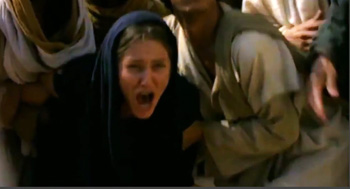
Mary, screaming & frantic during the Passion
Mary of Nazareth shows us the life of an ordinary girl who happens to become the Mother of the Messiah and acts accordingly. The real Mary, however, was perfect from the first instant of her blessed existence.
There are, admittedly, a few episodes that were beautiful and followed the Bible and Revelation, but they are of no account since the rest of the movie is full of inaccuracies, lies and blasphemies.
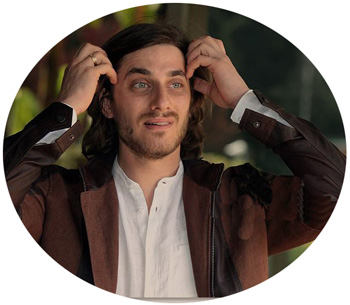
Director Giacomo Campiotti makes a false & naturalist portrayal of Mary of Nazareth
If you wish to learn about the life of our dear Mother and teach your children about her, instead of going to these deceiving films, go to the Saints and Mystics. Read the Revelations of Ven. Mary of Agreda and Anne Catherine Emmerich; read the writings of St. Alphonsus de Liguori and St. Louis de Montfort. These books can even be found online for free, unlike this terrible movie that you must pay to watch.
So many of the problems in the world and in the Church are because of a lack of knowledge and devotion to the Blessed Virgin, which results in a lack of knowledge of and devotion to her Son Jesus Christ.
As for us then, the happy few who have been given a little understanding about the dignity of God’s Holy Mother, let us continue to make reparation to her Immaculate Heart, teach the Catholic truths about her without compromise, and pray much for the hastening of the triumph of her Immaculate Heart.
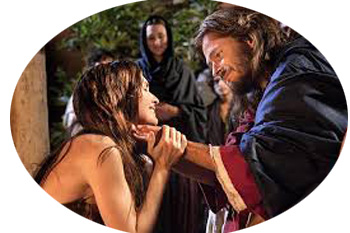
Jesus tenderly fondles an immodestly dressed Magdalene

Posted January 20, 2023
______________________
______________________





